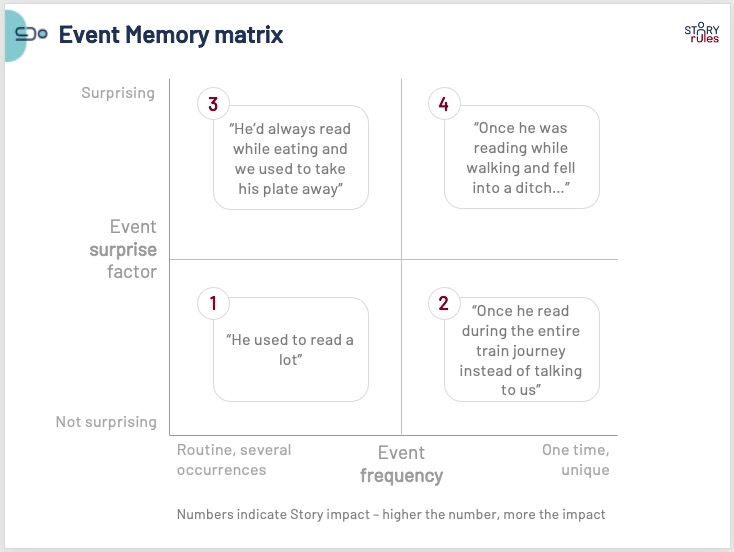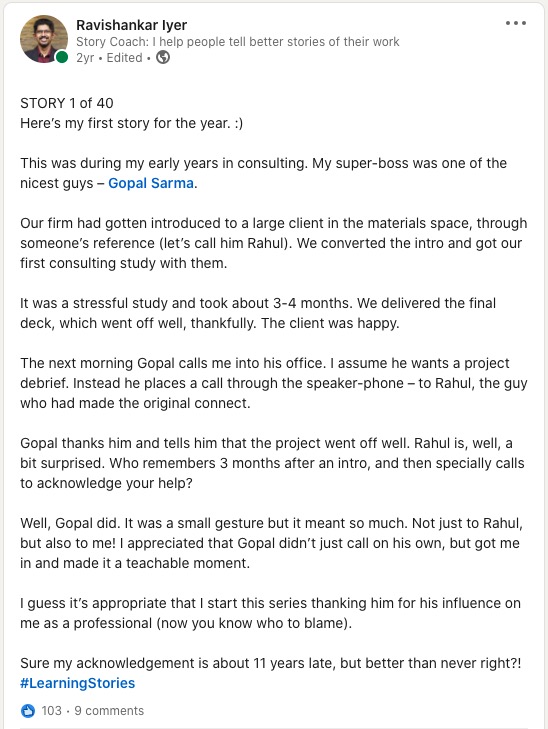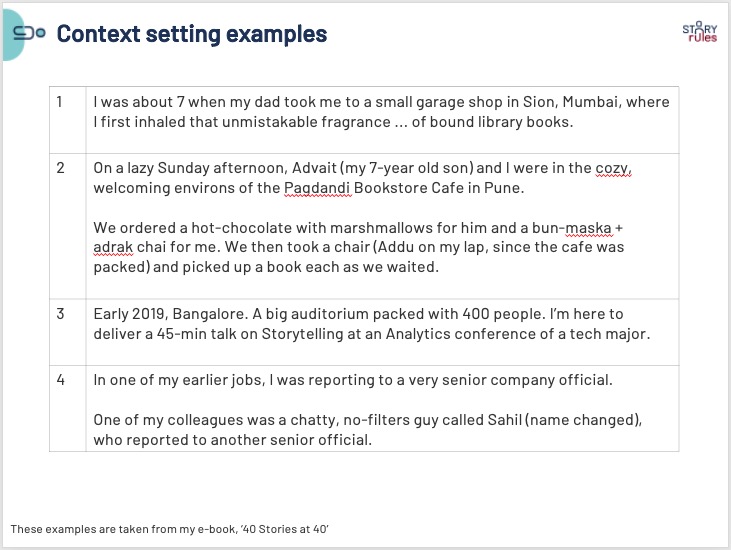Celebrate memories as stories
Last week, our IIMA WhatsApp group shared a shocking news – one of our batch-mates (let me call him Samir) had suddenly passed away due to a cardiac arrest.
We were struggling to process our emotions and come to terms with the event. Samir was only in his early forties.
As a means to share our grief, the batch decided to have a call with Samir’s family, comprising his elderly mom, his wife and a 9-year-old-son.
During the call, one by one several folks shared memories of their time with Samir… and it was all about his ever-smiling, friendly and happy-go-lucky nature.
I didn’t know Samir too well in campus or later. But I was struck by two questions.
One, why do we not share such happy memories and impressions about near and dear ones more often when they are with us?
And two, why is it so difficult to recollect and tell stories in these circumstances?
Often when we have to share memories of our loved ones, we struggle to remember actual incidents – or stories.
Which is a pity, because we have them hidden in our memory somewhere… and we know that these stories make for far more engaging conversations.
I especially like such stories to be narrated when we meet our friends and family for special get-togethers (think: your dad’s 70th birthday or a close college friend’s 40th birthday).
In today’s post, I will share some ideas for how you can increase the ‘story quotient’ in your conversations – especially during get-togethers… and especially with older folks at home.
I have four suggestions:
1. Turn conversations in special gatherings into story sharing sessions
2. Look for ‘surprising incidents’
3. Have a system for noting down such incidents when you remember them
4. Refine your story before you share it, to ensure it is engaging for the listeners
(Note: In this post, I use the word ‘story’ for what I call a ‘human story’. As I’ve written before, there are a lot of interpretations of the word story… of which the ‘human story’ is just one of them).
1. Turn conversations in special gatherings into story sharing sessions
What happens in most family/friend get-togethers?
You start with the pleasantries, talk about the weather, your health, kids, gossip, talk about the pandemic, cricket, some new OTT series or movie you’ve watched, and then… inevitably it spirals into politics.
What a waste of time spent together!
(Because, of course, the government/Indian cricket team/WHO/CCP are waiting with bated breath for what you and your family have to say about their performance)

If you have friends and family over for a long-awaited gathering, make the most of the time you spend together. Get folks – especially the older ones – to share stories!
I’ll share an example.
Last year, my father-in-law celebrated his 75th birthday. Among many others, one of his ex-colleagues came to wish him.
Now, the conversation would have normally gone into the same health-weather-news-traffic-politics spiral, but then I wanted to get some stories out.
And so I asked the ex-colleague (let’s call him Jay) if he remembered any interesting incidents with his ex-boss. He shared a great memory.
It so happened that, a few decades ago, my father-in-law and Jay were travelling on work from Delhi to Gujarat on their way to Mumbai, where they lived. They had picked up a couple of bottles of Scotch from Delhi airport and were getting it for a staff celebration in Mumbai.
Now unfortunately, they didn’t know about the strict rules against alcohol in Gujarat (it being a ‘dry-state’). They were duly caught by the airport police and the bottles were confiscated. All of this was happening in a waiting-room sort of place, with several passengers privy to the action that was unfolding before them.
My father-in-law pleaded with the authorities that this was not for use in Gujarat and it was meant for consumption in Mumbai… unsurprisingly, the airport staff didn’t buy that argument and insisted that he would have to discard the bottles.
After several rounds of back and forth, my father-in-law realised that they aren’t going to allow him to take it. Which is when he did a radical thing.
Instead of leaving it with the airport staff, he opened the two bottles, walked over to a section of the waiting room with a plant bed and then… proceeded to empty the two expensive Scotch bottles into the soil.
His message: If I can’t have it, neither can you.
The scene was witnessed by several passengers in that waiting room… who, on seeing this action, broke into spontaneous applause.
“That was the kind of person your father-in-law was”, concluded Jay, with a flourish.
The next time you have family or close friends coming over for a special occasion – especially the birthday or anniversary of an elderly person – try and gently steer the conversation to old memories and stories.
You’ll be pleasantly surprised by what you can unearth.
2. Look for surprising incidents
Often when we are asked to share our memories about a person, we struggle to remember interesting stuff.
Mostly, our responses tend to be: “Oh, he was very determined”, or “She always loved to lead since a young age”. But these are vague, abstract memories that don’t make for interesting conversation.
You need to ‘show, not just tell’.
For which, I have a suggestion: look for surprising incidents.
Think of your recollections of any person under this 2×2 Event Memory matrix. On one axis you have frequency of the event: ‘routinely occurring’ on one end and ‘one-time’ on the other. On the other axis is the surprise quotient. Was the event surprising or was it regular/boring/on expected lines given the person’s character?
For instance, imagine someone who used to read a lot as a child. Here is the (entirely fictional) Event Memory matrix:

Don’t get me wrong – I don’t mean here that you should only go for category #4 above. The sharing of all types of memories can be fun. It’s just that – the more surprising and one-time your incident, the more interesting it is for the audience.
For instance, instead of telling that my ex-senior-colleague, Gopal Sarma was great at building client relationships, I had shared this surprising incident about him:

That was surprising and a one-time incident that ‘shows’ Gopal’s client relationship skills in an evocative manner.
As did the story of the Scotch bottles being emptied in front of a cheering crowd.
We all have these incidents stored in our memories – all we need to do is ask the right questions and trigger them.
Which brings me to the next one. How do we remember them ourselves?
3. Have a system for noting down surprising incidents
Our memories are funny – they get triggered with random events out of nowhere, but in front of the right audience at the right time, they go blank.
Which is why its important to have a note-taking system to ensure you don’t leave story-sharing to the vagaries of your mental hard-disk.
I have two broad systems that I use:
- Evernote: I have a Notebook called ‘Stories from work and life’ where I quickly jot down any random memory that flashes in my mind. Most of the stories from my ’40StoriesAt40′ ebook came from this Evernote notebook.
- Google Sheet: I have a dedicated sheet for chronicling our kids antics. These are not proper stories always – they may just be a funny quip or new trick that the little tykes did. I find recording such incidents on a Google sheet (with the date) easier than opening a new note on Evernote.
Anyway, it doesn’t matter what system you use – just use one that works for you.
And if you worry about not having done something like this so far, remember the saying: The best time to plant a tree was 20 years ago. The next best time is now.
4. Refine your story before sharing
Having a funny or surprising incident is one thing. But making it engaging for the audience requires some additional skill.
Now, there have been bestselling books written on this skill. So it’s safe to say that the paragraphs below won’t be the defining thing said about this topic.
Having said that, here’s a quick four-part framework that can help:
a. Set the context
b. Build up to the climax
c. Reveal the climax
d. Explain the climax if needed
As you can see that a lot of the story is about the ‘climax’. A good story is like a joke. The climax is the punchline. (This famous TED talk by Andrew Stanton, Pixar director, makes that same point). It’s all about the build-up to that punchline.
Let’s go through the four steps:
a. Set the context
A good story is also like a time-travel machine. It should transport the listener to the time, place and context where it occurred. (“Once upon a time, in a galaxy far, far away…”).
Before starting with the main events, give your audience a sense of when and where it occurred. It’s useful to describe the setting visually to the best of your ability. You don’t have to get all ‘Malcolm Gladwell’ on it – just use simple words to describe what the scene was like.
Pro tip: Try to cover as many senses (visual, audio, smell, taste and touch) as you can, to the extent they’re relevant to the story.
Then, the characters. When describing your characters, you can mention the key traits that are relevant to the story.
Here are some examples of context setting from my ’40 Stories’ compilation:

b. Build up to the climax
In most incident stories, the most crucial part is the ‘Surprise’. Something remarkable that was either said (or done) by (or to) one of the characters. That ‘Surprise’ should be your climax (the punchline)… and before that, comes the buildup.
The buildup essentially is a series of events answering ‘what happened next’ until it reaches the finale…
c. Reveal the climax
The climax is the surprising part of the story, which should be worth the audience’s wait.
In my father-in-law’s story above, the climax was him emptying the bottles in the plant bed. The buildup was all the back-and-forth with the airport police.
In Gopal’s story, the climax was him calling an old client to thank him for a favour he did several months ago. The build-up was me going into the room wondering what this was all about.
When delivering the story, make sure you pause appropriately before revealing the punchline.
d. Explain the climax if needed
In classic narrative frameworks, this part is called the ‘denouement’ (which comes from the French word, meaning ‘unknot’). This is where a story differs from a joke – in a joke, one stops at the punchline (if you need to explain the joke, it kinda defeats the purpose).
In stories too, some folks believe that one should stop at the climax and leave it to the audience to form their own interpretation of the story. While that works for a corporate audience, when doing this at home, it’s perfectly alright to share what you took away from the story (and also invite others to share their thoughts!).
Most often when you finish sharing one story, it would trigger the memory of someone to share another interesting story/ies!
After all, the point of these stories is not to make a business point – it is to celebrate the memories of those we love.
To reiterate the four lessons:
1. Turn conversations in special gatherings into story sharing sessions
2. Look for surprising incidents
3. Have a system for noting down such incidents when you remember them
4. Refine your story before you share it, to ensure it is engaging for the listeners
a. Set the context
b. Build up to the climax
c. Reveal the climax
d. Explain the climax if needed
‘Storify’ your conversations during get-togethers. Make your time with your loved ones count.
Photo by S O C I A L . C U T on Unsplash








